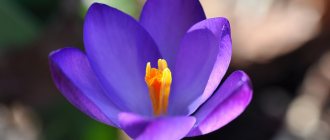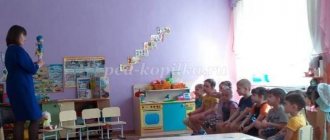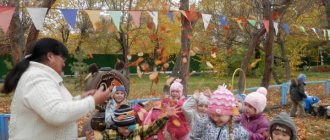Walk “Observing flowers in a flowerbed”
Walk “Observing flowers in a flowerbed”
Goal: Educational: - to form an idea of the diversity of inanimate nature; - learn to admire growing flowers. Developmental: —
develop the ability to generalize based on essential features;
- develop speech, activate vocabulary; - expand your understanding of plant parts. Educational: -
cultivate a responsible attitude towards nature;
- cultivate a caring attitude towards the beautiful creations of nature. Progress of the walk. Mystery.
The meadow is just like a chintz scarf of all colors - You won’t understand where the butterfly is, Where the living flower is. Forest and field in greenery, blue river, White, fluffy clouds in the sky.
Children.
In summer.
Educator.
- Guys, today I invite you to take a walk and look at our flower beds. (Children go to the flower beds.)
Listen to the poem.
I walk through a green meadow, the dew dries on the leaves, the wind sways the grass elastically, and I hear the voices of flowers. They whisper: “Don’t tear us, don’t, don’t crush our flexible stems. We are a delight for the eyes and the heart, an adornment of our native land.”
Educator.
- Guys, listen to the riddle.
Mystery .
The leaves bend in a spiral, And huddle together, And above them are those flowers, Not buds, but perfumes, What kind of flowers are these?
Children.
Lily (Invite the children to look at the flowers and remember the names.)
Because of their long stems, lilies are always planted inside the flower bed so that the flowers look beautiful among the shorter flowers at the periphery of the flower bed. The lily has a lot of lanceolate leaves, collected in a basal rosette, from which emerges a tall straight stem with an elegant flower. Lily flowers are orange, snow-white, tiger (speckled with black spots), etc. The root of the lily is a bulb. On a large lily flower it is very good to see the parts of the flower. The larger the flower, the better its parts are visible: the petals of the corolla, located on the receptacle, are large and orange; large black stamens with pollen sacs at the tips; in the middle there is one tall pestle.
Find identical flowers (lilies and petunias) and flowers collected in inflorescences. (Children find flowers).
Educator.
Listen to the riddle and say “What flower are we talking about?”
Mystery.
We bloom alone, summer
And we decorate the garden.
We look like velvet
Everyone will be happy to see us. (Marigold.)
Consider the differences between these colors.
Educator
.
All flowers are pleasing to the eye and decorate the surrounding space. Let's remember the poems.
1. We will water all the flowers on a hot, clear summer day. We will take care of the flowers so that they always bloom.
2. In spring and summer, here and there, flowers bloom to the joy of everyone: In the forest, in the field - wild, Fragrant, beautiful, alive. That's why I don't pick flowers. And you?
Didactic game “Flowers Shop”
Purpose:
to teach how to group plants according to their place of growth and describe their appearance.
Progress of the game.
Children play the roles of sellers and buyers. To make a purchase, you need to describe the plant you have chosen, but not name it, just say where it grows. The seller must guess what kind of flower it is, name it and the department of the store in which it is located (field, garden, indoor), then issue the purchase.
Educator.
- Guys, let's remember the signs. 1. Before the rain, roses and marigolds do not open their flowers. 2. By 8 o’clock in the morning, marigolds open their inflorescences. 3. Marigolds do not open their flowers - it means rain.
Experiment “Plant water requirements”
Children approach the flowerbed and pay attention to the condition of the flowers. Those flowers in flower beds that have not been watered for several days look drooping, the leaves are lowered to the ground. Those who watered stand with their heads held high.
Outdoor game “Developing attention” Purpose
: develop attention.
Progress of the game.
I suggest the children look around them (5-10 seconds) and remember as many colors as possible in order. Then blindfold. Swap the flower and ask them to list it in order as it was.
What changed?
Conclusion:
plants need water.
Labor on site
. Watering the flower beds.
Educator.
It's time for us to return to the group. — What new did you learn today?






